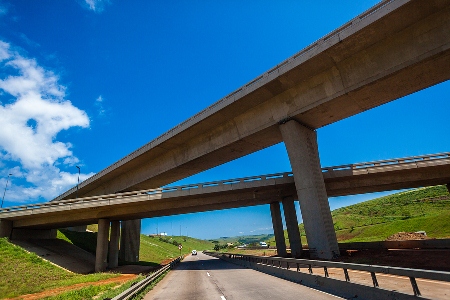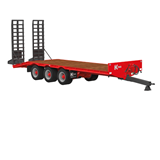Ageing infrastructure, lack of investment, energy availability and affordability, technology advances, vehicle dependence, not to mention a rapidly growing national freight load will all impact on the viability of Australia's transport network in the next three years and beyond.
That's according to the National Transport Commission (NTC), the inter-governmental agency charged with improving the productivity, safety and environmental performance of Australia's road, rail and intermodal transport system.
Last month the NTC announced a program to examine new ways to boost Australia's transport networks. The program includes both short and long term measures, some specific, some holistic, but all designed to improve what even a lay observer stuck in a 4pm traffic jam would concede is a vulnerable, if not creaking, national transport network.
Consultation with industry
Paul Retter, CEO of the NTC, said many of the initiatives were already under way, with priority in particular being given to consulting industry stakeholders.
"We are conscious of the importance of regular reviews in consultation with our stakeholders to ensure regulations are meeting best practice, can be complied with by industry and are achieving desired outcomes," Retter said.
"More than ever before we are tapping into the 'on the ground' experience of transport operators to make sure these projects identify the current concerns of industry and deliver sensible regulatory solutions that will give our transport networks a timely boost without diminishing safety outcomes.
"You can't have a more productive economy without more productive transport systems. This new work program will look at new ways to ensure transport operators can get goods to market more quickly and at a better price. Ultimately more efficient freight means lower prices for consumers and helps businesses create more jobs."
Retter said as a starting point the NTC was examining the feasibility of allowing 6 and 7-axle truck trailer combinations at Performance Based Standards (PBS) mass limits, without the need to apply for PBS.
Under the PBS scheme, 6 and 7-axle truck-trailer combinations can operate with up to 20 per cent higher payloads than their non-PBS equivalents.
"Over the past 18 months, PBS applications and vehicle approval numbers for this combination have doubled," Retter said.
"The benefits of this combination have been proven through the PBS scheme and making them more accessible would allow for more operators to take advantage of these benefits, if it proves feasible."
Longer term
However, many of Australia's transport problems require a longer term fix. Better data was required, Retter said, to inform future planning and investment in relation to freight and passenger movements, as well as to better understand the impact of heavy vehicle driver fatigue and the cost to industry of regulatory compliance.
Technology will also have a role to play, from the increased availability of sensing and computing devices to preparing the country for the introduction of autonomous road and rail vehicles.
According to Retter, infrastructure constraints coupled with a rapidly growing national freight task had left the country vulnerable to disruption and bottlenecks, and demanded investment.
Just this week the peak industry body for the Australian logistics industry, the Australian Logistics Council (ALC), published a report that found while the logistics sector added some $131 billion a year to GDP, and employed over 1.2 million people, inefficiencies in the industry were costing Australia billions of dollars.
Small improvements, big gains
ALC Managing Director, Michael Kilgariff, said if government at every level focused on reforming regulation and infrastructure even a 1 per cent increase in productivity would translate to an increase in GDP to the tune of $2 billion a year.
"The logistics industry is the backbone of the Australian economy…the report demonstrates that with focus and attention on reform, greater efficiencies can be achieved across the supply chain and all Australians will benefit as a result," Kilgariff said.
"The logistics industry is critical to every business and consumer in the country, yet it does not get the attention it deserves."
Kilgariff urged all levels of government to study the report and to put in place policies and legislation to reap the benefits from a more efficient logistics industry. Their constituents, he said, would expect nothing less.
"The industry faces multiple threats to efficiency which cry out for action, including nationally significant logistics infrastructure, greater certainty on planning for freight, eliminating overlapping regulations which affect productivity and ensuring there is a whole-of-supply chain focus on strategic corridors," Kilgariff said.
"Australia's rising freight task makes it essential that government, industry and the community put aside sectional and regional interests and focus on improving national supply chain efficiency for the greater national good."
According to the report in 2011-12 the domestic freight task totalled almost 600 billion tonne kilometres – about 26,000 tonne kilometres for every person in Australia. Meanwhile government figures show Australia's freight task is projected to increase by 80 per cent between 2010 and 2030 and triple by 2050. Delaying action any further – the report found – could have devastating ramifications into the future.
Future proofing
If indeed Australia's freight task does multiply to 1,800,000,000,000 tonne kilometres by 2050, then a 30 year strategy – rather than a 3 year government term of office plan – will be essential according to Asciano CEO and Managing Director, John Mullen.
Asciano is the region's largest combined rail and ports operator, handling and hauling millions of tonnes of agricultural and resource commodities, retail goods, manufacturing products, construction and other materials each year.
Speaking at the ALC Forum in Sydney earlier this year, Mullen said three priorities had to be placed above all others – seamless national regulation; freight infrastructure investment directed where it would have the greatest benefit; and first and foremost a long-term master plan for Australia's freight task.
He said Australia needed a 30-year integrated national freight master plan to ensure we set a clear pathway toward an efficient, productive and integrated national freight network.
"Freight and infrastructure investments are long cycle plays and the private sector needs certainty and long-term direction if it is to have a leading role in funding and operating Australia's freight network," Mullen said.
"We must establish a clear destination – where we want to be in 20-30 years – and set out the infrastructure priorities to reach this destination. As part of this, we must establish and set priority projects and five-year targets to measure progress as we move forward.
"We conduct endless debate about major infrastructure investment but see glacial progress in actually implementing such investment. We need to work to a master plan…and then move beyond electoral cycles in delivering our stated infrastructure plans."
- Suppliers
- New to IndustrySearch? Book a Demo
- Advertise with us
- Login
- Email Marketing
- Buyers
- Get Quotes
- Articles & Ideas
- Login
- Subscribe to newsletter
- My Details
- Get Quotes
- Automation & Control
- Automotive Workshop Equipment
- Cleaning Equipment
- Construction & Heavy Machinery
- Conveyor Systems & Components
- Cranes & Hoists
- Electrical & Power Generation Equipment
- Electronic Components
- Farming & Agriculture
- Food & Beverage Processing
- Forklifts & Attachments
- Hydraulic & Pneumatic Equipment
- Industrial Materials, Tools & Components
- Industrial Pumps
- IT Hardware & Industrial Computing
- IT Software & Applications
- Laboratory Equipment & Instruments
- Manufacturing & Industrial Equipment
- Material Handling & Lifting
- Metalworking & Machining
- Mining Equipment & Machinery
- Packaging & Labelling Machinery
- Pallet Management
- Personal Protective Equipment
- Security & Surveillance
- Test & Measurement
- Transport Equipment
- Trucks & Trailers
- Warehouse Storage & Racking
- Waste & Environmental Management
- Welding Machines & Accessories
- Woodworking & Joinery Machines
- Workplace Equipment
- Workplace Safety Equipment
- Get Quotes
- Automation & Control
- Automotive Workshop Equipment
- Cleaning Equipment
- Construction & Heavy Machinery
- Conveyor Systems & Components
- Cranes & Hoists
- Electrical & Power Generation Equipment
- Electronic Components
- Farming & Agriculture
- Food & Beverage Processing
- Forklifts & Attachments
- Hydraulic & Pneumatic Equipment
- Industrial Materials, Tools & Components
- Industrial Pumps
- IT Hardware & Industrial Computing
- IT Software & Applications
- Laboratory Equipment & Instruments
- Manufacturing & Industrial Equipment
- Material Handling & Lifting
- Metalworking & Machining
- Mining Equipment & Machinery
- Packaging & Labelling Machinery
- Pallet Management
- Personal Protective Equipment
- Security & Surveillance
- Test & Measurement
- Transport Equipment
- Trucks & Trailers
- Warehouse Storage & Racking
- Waste & Environmental Management
- Welding Machines & Accessories
- Woodworking & Joinery Machines
- Workplace Equipment
- Workplace Safety Equipment
Trusted by 1.2 million Australian industrial buyers
Buyers
- Discover products & solutions
- Login
- Subscribe To Newsletter
- Browse All Products
- Read Articles
Suppliers
Advertise
- Promote your products & solutions
- New to IndustrySearch? Book a Demo
- Login / Forgot Password
- Advertise Your Products
- Success Stories
- Email Marketing
- Suppliers
- Advertise with us
- Login
- Email Marketing
- Buyers
- Get Quotes
- Articles & Ideas
- Login
- Subscribe to newsletter
- My Details
Get Quotes
- Automation & Control
- Automotive Workshop Equipment
- Cleaning Equipment
- Construction & Heavy Machinery
- Conveyor Systems & Components
- Cranes & Hoists
- Electrical & Power Generation Equipment
- Electronic Components
- Farming & Agriculture
- Food & Beverage Processing
- Forklifts & Attachments
- Hydraulic & Pneumatic Equipment
- Industrial Materials, Tools & Components
- Industrial Pumps
- IT Hardware & Industrial Computing
- IT Software & Applications
- Laboratory Equipment & Instruments
- Manufacturing & Industrial Equipment
- Material Handling & Lifting
- Metalworking & Machining
- Mining Equipment & Machinery
- Packaging & Labelling Machinery
- Pallet Management
- Personal Protective Equipment
- Security & Surveillance
- Test & Measurement
- Transport Equipment
- Trucks & Trailers
- Warehouse Storage & Racking
- Waste & Environmental Management
- Welding Machines & Accessories
- Woodworking & Joinery Machines
- Workplace Equipment
- Workplace Safety Equipment
Get Quotes
- Automation & Control
- Automotive Workshop Equipment
- Cleaning Equipment
- Construction & Heavy Machinery
- Conveyor Systems & Components
- Cranes & Hoists
- Electrical & Power Generation Equipment
- Electronic Components
- Farming & Agriculture
- Food & Beverage Processing
- Forklifts & Attachments
- Hydraulic & Pneumatic Equipment
- Industrial Materials, Tools & Components
- Industrial Pumps
- IT Hardware & Industrial Computing
- IT Software & Applications
- Laboratory Equipment & Instruments
- Manufacturing & Industrial Equipment
- Material Handling & Lifting
- Metalworking & Machining
- Mining Equipment & Machinery
- Packaging & Labelling Machinery
- Pallet Management
- Personal Protective Equipment
- Security & Surveillance
- Test & Measurement
- Transport Equipment
- Trucks & Trailers
- Warehouse Storage & Racking
- Waste & Environmental Management
- Welding Machines & Accessories
- Woodworking & Joinery Machines
- Workplace Equipment
- Workplace Safety Equipment
Trusted by 1.2 million Australian industrial buyers







-160x160-state_article-rel-cat.png)







-160x160-state_article-rel-cat.png)







-160x160-state_article-rel-cat.png)
-160x160-state_article-rel-cat.png)





